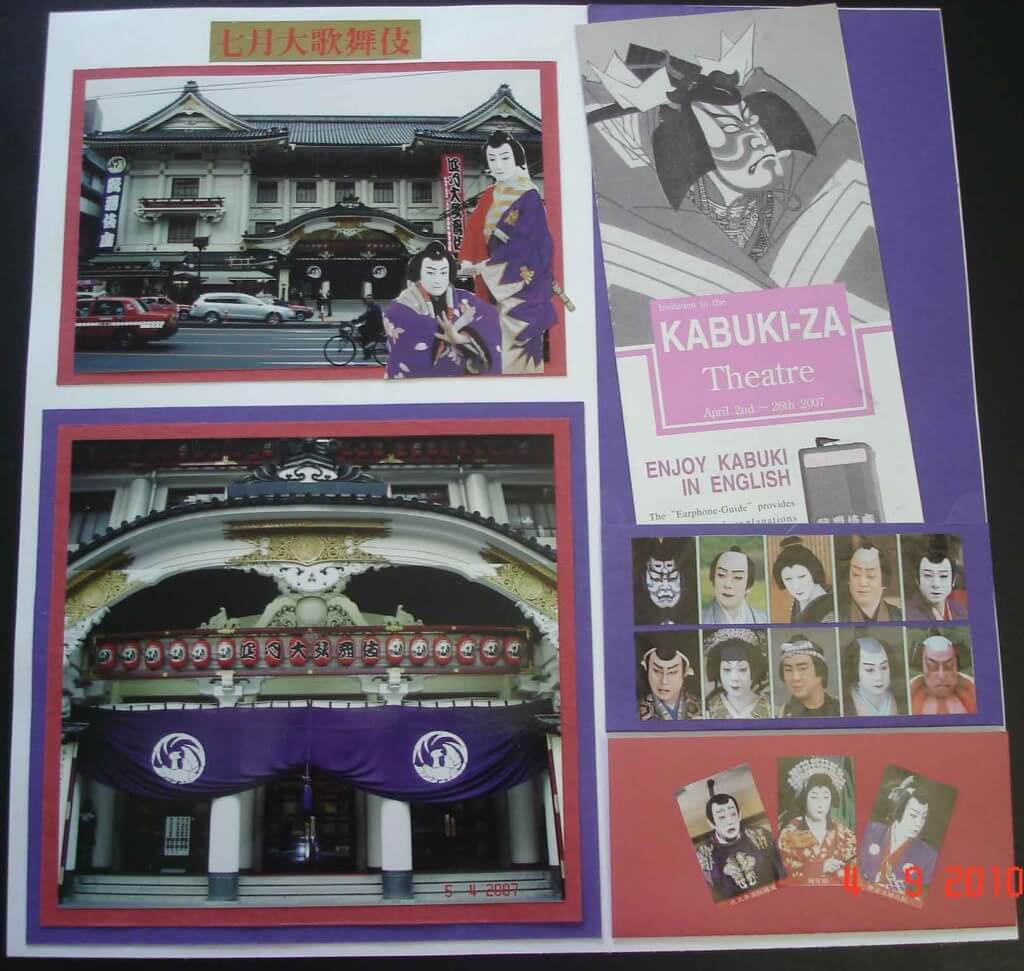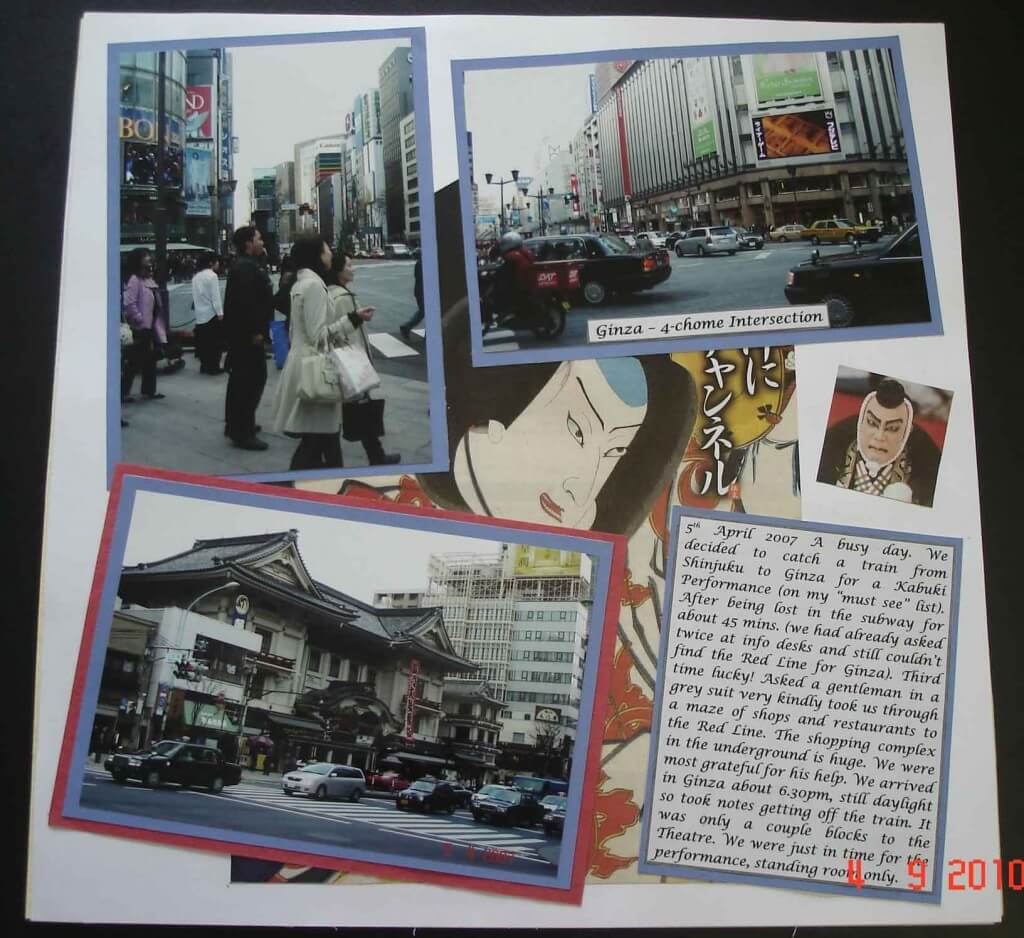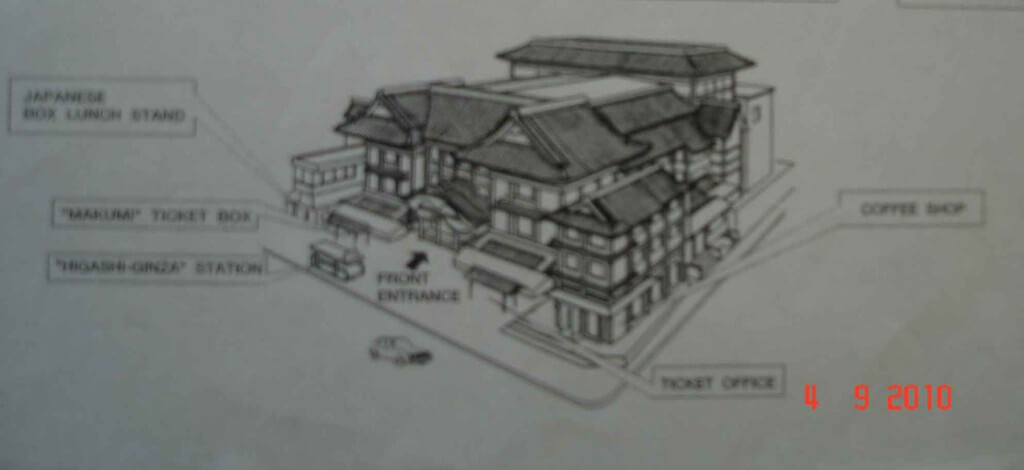DEVASTATED TO LEARN OF THE DEMOLITION OF THE JAPANESE KABUKI-ZA THEATRE
I’ve only just caught up with the fact the Japanese Kabuki-za Theatre in Ginza, Tokyo, Japan has been demolished. I was quite devastated when I read this fact. It means that one of the most loved and traditional of Japanese shows will no longer be able to be performed in this wonderful Japanese Kabuki theatre.
Then, I realized how lucky we were to see a Japanese Kabuki performance in this theatre on our tour of Japan in 2007. On that night after the initial performance, we had the privilege and excitement of watching the KOJO (Stage Announcement) when the Living National Treasure Jakuemon was on stage to congratulate the new Kinnosuke, Nakamura Shinjiro who is the nephew of the famous Japanese Kabuki actor Nakamura Kinnosuke (1932-1997). We thought this a very auspicious occasion and I loved every minute of the dramatics.
The scheduled demolition of this famous Japanese Kabuki Theatre was in the spring of 2010 (earlier this year), the theater rebuild expected to take three years. Apparently there were serious concerns as to whether the building would survive a serious earthquake, as well as accessibility and fire hazard issues.
Between January and April this year (2010) a series of farewell performances were held, entitled Kabuki-za Sayonara Koen (“Kabuki-za Farewell Performances”). If only? I so wish I could have been there for one of these performances.
It’s not all bad new, if your travel destination is to Tokyo Japan, you will still be able to see a Japanese Kabuki performance in the Shinbashi Theatre, and as well, take in the different plays developed within the kabuki genre and performed at Shinbashi Enbujo. These are plays which include Super Kabuki form, and Hanagata Kabuki , a performance featuring the younger generation of kabuki stars. This would be a very interesting and different performance.
Future Japanese Kabuki theatre performances will take place in the Shinbashi Enbujo (only a couple of blocks away), until the new Japanese Kabuki-za theatre complex is completed in 2013.
Below is the address and subway directions for the Shinbashi Enbujo.
The Shinbashi theatre is located in Higashi Ginza Area in Tokyo.
The address is: Ginza 6-18-2, Chuo-ku, Tokyo Japan.
By Subway:
Take the Hibiya Line or Asakusa Line to Higashi Ginza Station. Exit 6
Take the Ōedo Line to Tsukiji Shijō Station. Exit A3
FACTS ABOUT THE JAPANESE KABUKI-ZA THEATRE IN GINZA
- The original Japanese Kabuki-za theatre was a wooden building built-in 1889, on the ground where the Hosokawa clan of Kumamoto, or the Matsudaira clan (a Japanese Samaurai clan) resided in Tokyo.
- It burnt down in 1921 because of an electrical fault.
- Construction of the new Kabuki theatre began in 1922. Designed to be fireproof, whilst incorporating a traditional Japanese architectural style.
- The new Kabuki Theatre had not been completed when the 1923 Great Kanto earthquake struck.
- After the earthquake the new Japanese Kabuki Theatre was built-in a baroque Japanese revivalist style, which combined architectural details of Japanese castles and temples of pre-Edo period.
- Once again, destruction, when the theater was heavily damaged in World War II bombings.
- Finally,a happy ending when restored in 1950, preserving the style of 1924 construction (as I saw it in 2007). It was a very dramatic and beautiful traditional building and the most famous Japanese Kabuki-za Theatre in the world.
- Demolished after April, 2010. Not a very good run!
So very sad to think it has been demolished!
On a brighter note, I’m sure the Japanese will come up with a wonderful and new dramatic Japanese Kabuki-za Theatre in 2013. Who knows, perhaps I can be there for an opening performance!
Update
Reconstruction of a magnificent new Kabuki-za Theatre completed and the theatre re-opened in April 2013. For full details go to their website:
http://www.japan-guide.com/e/e2090.html
Related Posts:



Unfortunately, this is happening all over Japan and not just with Kabuki. A lot of traditional Japanese arts are becoming endangered and about to be lost forever. The latest is the traditional handmade kimono, which now only has a handful of master craftsmen left with little or no enthusiasm from the younger generation to continue this craft.
Hi John
It would be a tragedy to lose the grace and beauty the kimono brings to its wearers. I saw a number of Japaneses business women attending a conference in Kanazawa wearing their beautiful Kimonos, they looked stunning. It would be such a tragedy for you culture if this craft is not continued.
Have you any idea on what the new plans for the Kabuki Theatre might be? Any chance it will be a traditional style? I would be interested in any info. Thanks so much for your comments. Lyn
The traditional shows and performance is a way the next generation will inform about the past tradition and of course in this way they could really remind the next generation, about the culture of the Japanese.
The government must support this traditional performance because it is a part of education to the children and to the youth.
Hi Lynie, You are so right. The tradition of the Kabuki theatre has been passed down for generations and it is very important for this to continue, and for the younger generation to be given an appreciation of its importance in their culture. Thanks for your comments. Lyn
Were there any kabuki theatres impacted by the tsunami?
Hi Stan, I don’t really know, probably not. The five main theatres where Kabuki is performed are in Tokyo, Kyoto, Osaka, Asakusa and Ginza which are outside the tsunami area.
Have you seen the Kabuki-za theater after it was demolished? I was thinking the same thing as Stan about the earthquake. At least you have your own memory of the theater 🙂
Hi Leah, I believe rebuilding is still continuing on the site of the demolished Kabuki-za theater. Kabuki performances are still continuing at all the other Kabuki Theaters throughout Japan. The Theaters have been running an appeal to assist all the areas affected by the earthquake and Tsunami disaster earlier this year.
Our culture defines who we are as a nation so this is quite disappointing, I know of other historical sites brought to the ground due to rapid commercialization. Thanks for the share though.
It is sad to see historical buildings disappear and lost. You must be witnessing a great deal of change in Bali with commercialization. Your Villas will remain a welcome cultural haven. Natural Bali is a beautiful place. I hope to visit again one day. thanks for your comments.